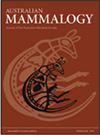A brief history of the northern quoll (Dasyurus hallucatus): a systematic review
IF 1.2
4区 生物学
Q3 ZOOLOGY
引用次数: 7
Abstract
In response to Australia’s current extinction crisis, substantial research efforts have been targeted towards some of the most imperilled species. One such species is the northern quoll (Dasyurus hallucatus), a marsupial predator that has recently suffered substantial declines in range and is now listed as Endangered. We conducted a systematic review of all literature relevant to the conservation and ecology of northern quolls. We reviewed 143 studies, including research articles, government and industry reports, theses, and books, and quantified research effort in terms of topic, location, and publication period. We then summarised research relevant to northern quoll taxonomy, genetics, distribution, habitat associations, diet, reproduction, movement, threats, management, and Indigenous knowledge. Research effort was higher between 2011 and 2020 than the previous four decades combined. Northern quolls in the Northern Territory were the most studied, followed by the Pilbara, the Kimberley, and Queensland populations. Most studies focused on northern quoll distribution and habitat, management, and threats – primarily cane toads, predation, and fire. We conclude with a non-exhaustive list of ten future research directions. If pursued, these future research directions should provide information critical to managing and conserving northern quolls.北袋鼬(Dasyurus hallucatus)简史:系统回顾
为了应对澳大利亚目前的灭绝危机,大量的研究工作已经针对一些最濒危的物种。其中一个物种是北袋鼬(Dasyurus hallucatus),这是一种有袋类食肉动物,最近其活动范围大幅减少,现在已被列为濒危物种。我们对所有与北袋鼬保护和生态有关的文献进行了系统的综述。我们回顾了143项研究,包括研究论文、政府和行业报告、论文和书籍,并根据主题、地点和出版时间对研究工作进行了量化。然后,我们总结了与北方袋鼬分类、遗传、分布、栖息地关联、饮食、繁殖、运动、威胁、管理和土著知识相关的研究。2011年至2020年期间的研究投入比此前40年的总和还要多。研究最多的是北领地的北袋鼬,其次是皮尔巴拉、金伯利和昆士兰。大多数研究集中在北部袋鼬的分布和栖息地,管理和威胁-主要是甘蔗蟾蜍,捕食和火灾。最后,我们列出了十个未来的研究方向。如果继续进行,这些未来的研究方向将为管理和保护北袋鼬提供关键信息。
本文章由计算机程序翻译,如有差异,请以英文原文为准。
求助全文
约1分钟内获得全文
求助全文
来源期刊

Australian Mammalogy
ZOOLOGY-
CiteScore
2.50
自引率
8.30%
发文量
26
期刊介绍:
Australian Mammalogy is a major journal for the publication of research in all branches of mammalogy. The journal’s emphasis is on studies relating to Australasian mammals, both native and introduced, and includes marine mammals in the Antarctic region. Subject areas include, but are not limited to: anatomy, behaviour, developmental biology, ecology, evolution, genetics, molecular biology, parasites and diseases of mammals, physiology, reproductive biology, systematics and taxonomy.
Australian Mammalogy is for professional mammalogists, research scientists, resource managers, consulting ecologists, students and amateurs interested in any aspects of the biology and management of mammals.
Australian Mammalogy began publication in 1972 and is published on behalf of the Australian Mammal Society.
 求助内容:
求助内容: 应助结果提醒方式:
应助结果提醒方式:


